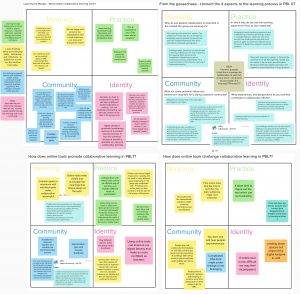
During the two weeks of collaborative learning in our PBL-group we started to work collaboratively through digital tools online for the first time (if not to include google drive and zoom itself of course). The difference was that we decided to direct our attention to a specific question by using Wengers theories of collaborative learning (Wenger 2009).
We draw on the four aspects Community (as belonging), Identity (as becoming), Meaning (as experience) and Practice (Doing).
We started up the discussion the first meeting by defining each aspect in the mural and how it could work for us. In the next step we decided to use a collaborative app: Goosechase (https://www.goosechase.com/) and connected the 4 aspects to our process of collaborative learning in PBL07 to questions to answer by all participants in the group. We wanted a different and new way of collaborating asynchronously where we tried to connect all concepts together. In the beginning we thought that it was to much to connect a totally different tool to the platform mural. This as mural is built for collaboration and the goose chase foremost for constructing a type of quiz, hence implicating that there are “wrong” and “right” answers. But in the end we found it useful as we could use goose chase for short and fast reflections through the mobile phones and actually we just copied in the answers in the mural. In this sense it became a fast way to just get everyone part of starting up the thinking between the meeting and then we met and continued working o the mural with everybody’s contributions as a starting point for discussions. Finally, we extended the mural and reflected on how online tools can promote and challenge collaborative learning within our group based on this experience.
If you want to see our mural: https://app.mural.co/invitation/mural/onltopic36438/1681394695110?sender=ubc58f76ec05419204ca83162&key=3c6af043-79bf-47dd-975e-e86d77b99adc
Using mural for collaborative processes of creating products seems to be easy. Additionally, the learning has automatically collaborative aspects as we are working in the same platform and can build on to the groups contributions.
Sources:
Wenger, E. (2009). A social theory of learning. In K. Illeris (Ed.), Contempoary Theories of Learning: Learning theorists…in their own words (pp. 210–218).
Visa Penttilä
May 10, 2023 — 3:24 pm
I think this was the most successful exercise we did in the group. The chosen tools supported collaborative inquiry and everyone contributed to the work. Using Mural and Goosechase seem to have encapsulated Wenger’s dimensions quite well; we were constructing meaning of what collaborative learning is; we were learning by doing the Mural; clearly we belonged to the community of learners as we worked on the Mural; and finally, perhaps there was a bit of a change in how each of us related to collaborative learning.
Hanna Dort
May 23, 2023 — 10:47 am
Hey Larissa,
The goosechase app looks like it could be a lot of fun to use! Its website makes it seem like it’s mostly used for scavenger hunts; how do members of your PBL group use it in their teaching? Do students like getting point values for completing activities?
I think using a similar app could have really helped me when my group was making a Miro board — I had to live transcribe everything on the fly, so it was really hard for me to actually follow the conversations being held.
Thanks for this!
Hanna